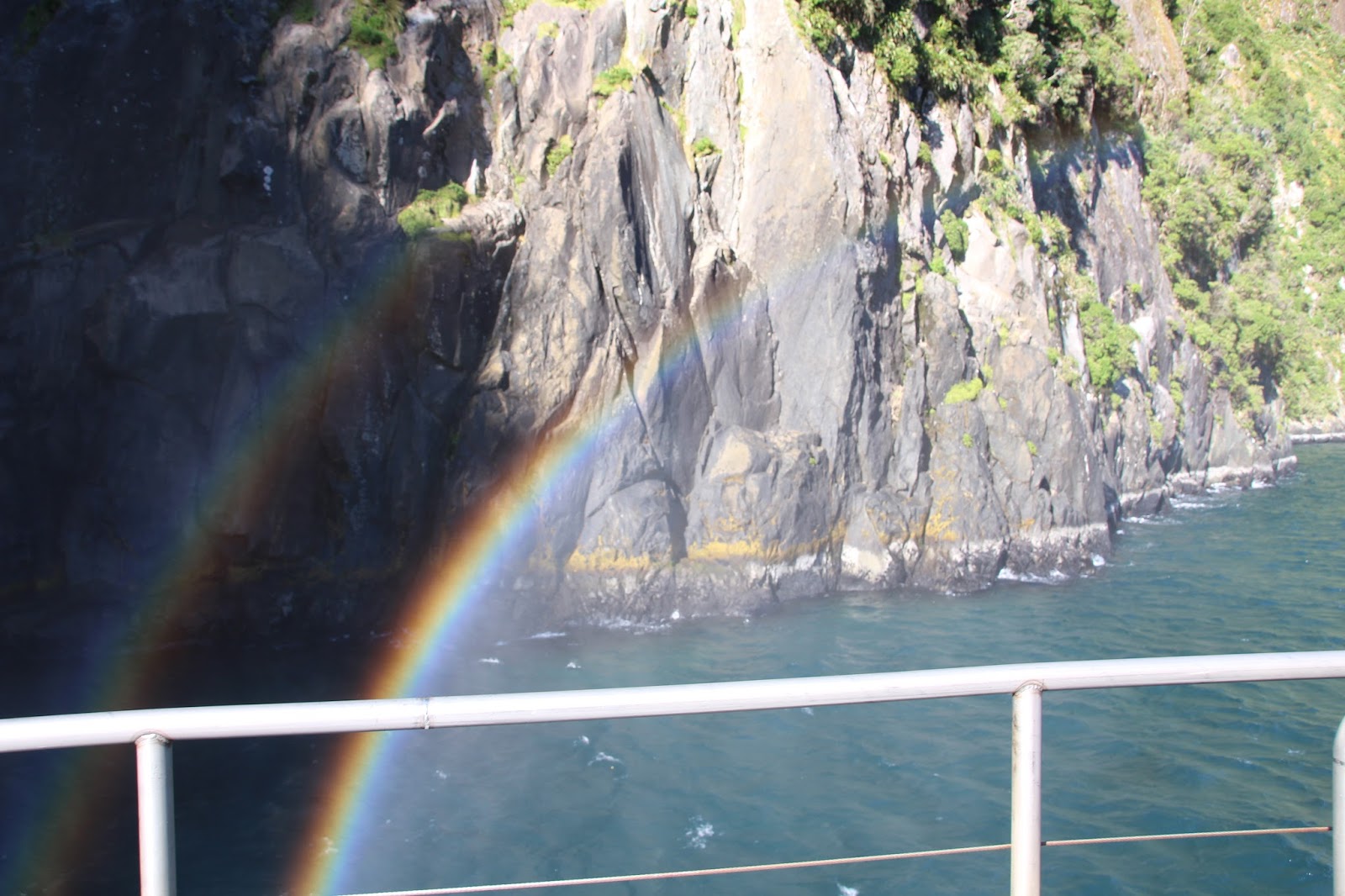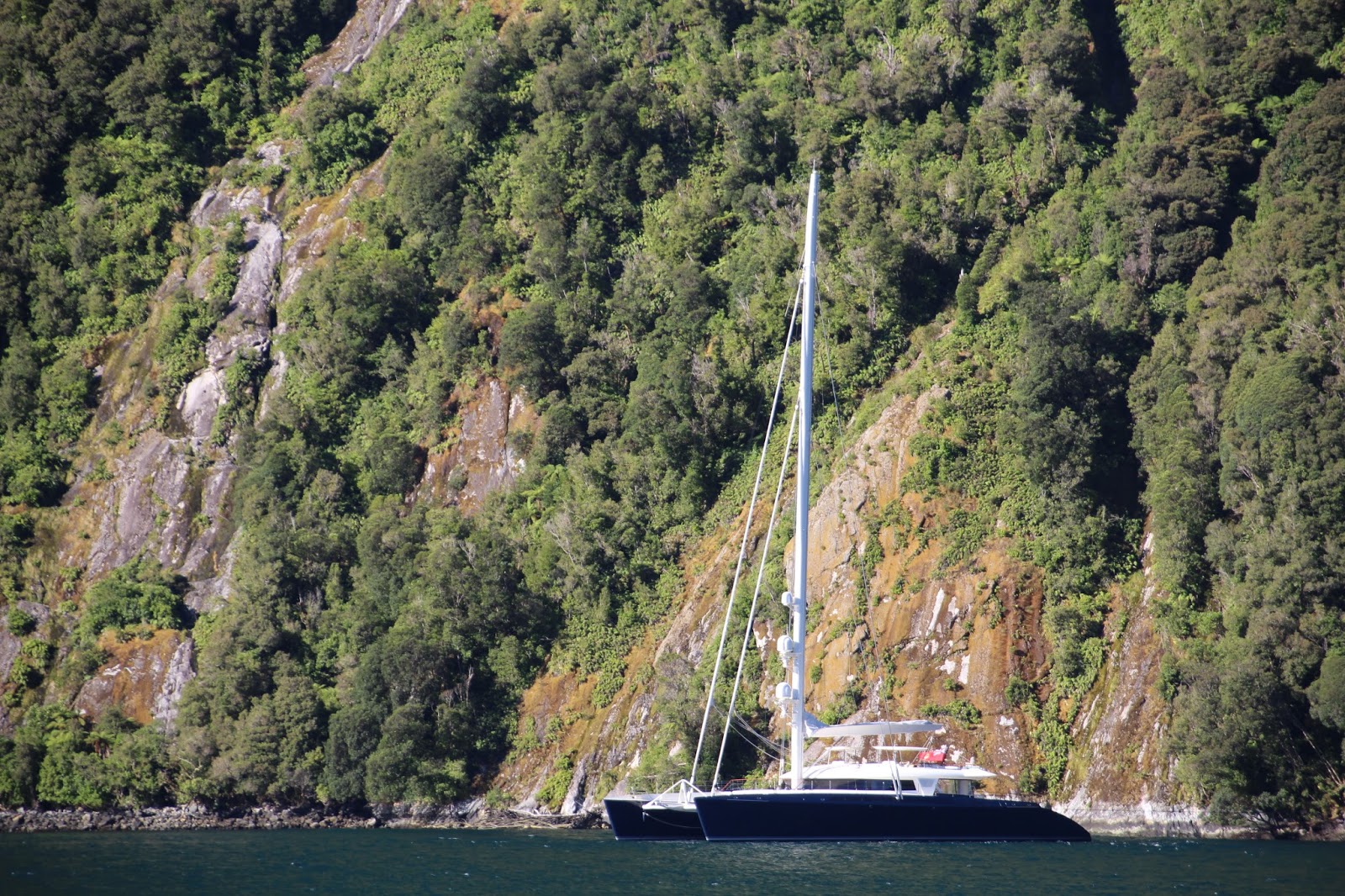St. Patrick's Day
Tour length: 2 Days
Tour Pickup Location: Queenstown
Tour Dropoff Location: Queenstown
Departing from: Peppers Beacon at 08:20 a.m.
A taxi will collect you from your accommodation and take you to the Real Journeys Visitor Centre,
where you will join your coach connection. Please be ready at reception at your departure time.
It is a rather cool morning.
Our taxi arrives, but really, we could have walked to the pick up spot in less than five minutes. We register with Real Journeys and snare the front row seat on the bus. We are getting to be pros at this tour bus game.
Our driver is Brent, and he is Maori. Very gentle and mellow. We make a few more pick ups on the way out of town.
Leaving Queenstown you soon reach ski country, amongst the southern Alps is The Remarkables range- a distinctive, craggy topped mountain that towers over the city.
There are 40 million sheep in New Zealand, yes, you read that right. And the population of the south island is 1.1 million.
It started to rain as we leave town.
Our first pit stop was a coffee cafe, Five Rivers, and it is really raining now. We have it down to an art and are first in line wherever possible. We divide and conquer.
The South Island or Te Waipounamu is the larger of the two major islands of New Zealand, the other being the smaller but more populous North Island. It is bordered to the north by Cook Strait, to the west by the Tasman Sea, and to the south and east by the Pacific Ocean. The South Island covers 150,437 square kilometres (58,084 sq mi) and is influenced by a temperate climate.
We make a stop to drop some passengers off for their boat trip to Doubtful Sound.
Te Anau and Milford Sound are 121 km apart by road. But the road twists and turns through the rugged yet scenic alpine stretches, making it a rather challenging drive. In places, the roads are narrow and winding. John enjoys being driven so he can take in the sights. It is also great to have a guide to explain the various history and geography.
We then have a forty minute stop in Te Anau for lunch, drop off some people and pick up some others.
We pass the 45th parallel. It is the line that marks the theoretical halfway point between the equator and the South Pole. (The true halfway point is 16.2 kilometres (10.1 mi) south of this parallel because the Earth is not a perfect sphere but bulges at the equator and is flattened at the poles.
Unlike its northern counterpart it passes mostly over open ocean. It crosses the Atlantic Ocean, the Indian Ocean,Australasia, the Pacific Ocean and South America.
At this latitude the sun is visible for 15 hours, 37 minutes during the December solstice and 8 hours, 46 minutes during solstice.
The Homer tunnel is an engineering feat.
The Homer Tunnel is a 1.2 km (0.75 miles) long road tunnel in the Fiordland region of the South Island of New Zealand, opened in 1954.New Zealand State Highway 94 passes through the tunnel, linking Milford Sound to Te Anau and Queenstown, by piercing the Darran Mountain range at the Homer Saddle. It connects between the valley of the Hollyford River to the east and that of the Cleddau to the west.
The tunnel is straight and was originally single-lane and gravel-surfaced. The tunnel walls remain unlined granite. The east portal end is at 945 m elevation; the tunnel runs 1270 m at approximately a 1:10 gradient down to the western portal Until it was sealed and enlarged it was the longest gravel-surfaced tunnel in the world.
Government workers began the tunnel in 1935 and the completion of at least a rough road to the eastern portal site in the same year The tunnel and the associated Milford Road were built by relief workers during the Depression, initially just starting with five men using picks and wheelbarrows. The men had to live in tents in a mountainous area where there might be no direct sunlight for half of the year. At least three were killed by avalanches over the coming decades.
Progress was slow, with difficult conditions including fractures in the rock bringing water from snow melt into the tunnel. Compressors and a powerhouse in the nearby river were eventually built to pump out 40,000 litres of water per hour. Work was also interrupted by World War II (though the actual piercing of the mountain had successfully been achieved in 1940), and an avalanche in 1945 which destroyed the eastern tunnel portal. These problems delayed the tunnel's completion and opening until 1954.
The Homer Tunnel is a 1.2 km (0.75 miles) long road tunnel in the Fiordland region of the South Island of New Zealand, opened in 1954.New Zealand State Highway 94 passes through the tunnel, linking Milford Sound to Te Anau and Queenstown, by piercing the Darran Mountain range at the Homer Saddle. It connects between the valley of the Hollyford River to the east and that of the Cleddau to the west.
The tunnel is straight and was originally single-lane and gravel-surfaced. The tunnel walls remain unlined granite. The east portal end is at 945 m elevation; the tunnel runs 1270 m at approximately a 1:10 gradient down to the western portal Until it was sealed and enlarged it was the longest gravel-surfaced tunnel in the world.
Government workers began the tunnel in 1935 and the completion of at least a rough road to the eastern portal site in the same year The tunnel and the associated Milford Road were built by relief workers during the Depression, initially just starting with five men using picks and wheelbarrows. The men had to live in tents in a mountainous area where there might be no direct sunlight for half of the year. At least three were killed by avalanches over the coming decades.
Progress was slow, with difficult conditions including fractures in the rock bringing water from snow melt into the tunnel. Compressors and a powerhouse in the nearby river were eventually built to pump out 40,000 litres of water per hour. Work was also interrupted by World War II (though the actual piercing of the mountain had successfully been achieved in 1940), and an avalanche in 1945 which destroyed the eastern tunnel portal. These problems delayed the tunnel's completion and opening until 1954.
Only one overnight bag allowed per passenger on board for convenience and safety reasons. Don't forget your rain jacket and bathing suit.
Limited lock-up storage facilities are available at the Milford Sound Visitor Terminal, Milford
Sound.
You will be transferred to Milford Sound. The Milford Mariner offers a very special dinner, bed and breakfast experience. Designed along the lines of a traditional New Zealand coastal trading scow to reflect Fiordland's heritage, the Milford Mariner caters for visitors who enjoy comfort, combined with activity. The vessel has been purpose built to accommodate passengers in private cabins with en-suite bathrooms.
We get to Milford sound and check in and get our boarding cards. Boarding commenced at 4:30 and we stopped for the requisite photo.
It has a spacious dining saloon, observation lounge and large open deck areas for viewing the scenery of Milford Sound.
Departing from the Milford Wharf, the Milford Mariner cruises the length of Milford Sound to the Tasman Sea.
After a safety briefing and staff introduction we head to our tiny cabin. It is on par with one on the Russian river cruise. But it is for only one night.
We head outside as we set sail to look at this incredible fiord. Rudyard Kipling did not call it the "eighth wonder" for nothing.
Milford Sound runs 15 kilometres inland from the Tasman Sea at Dale Point (also named after a location close to Milford Haven in Wales) - the mouth of the fiord - and is surrounded by sheer rock faces that rise 1,200 metres (3,900 ft) or more on either side. Among the peaks are The Elephant at 1,517 metres (4,977 ft), said to resemble an elephant's head and The Lion, 1,302 metres (4,272 ft), in the shape of a crouching lion.
Milford Sound sports two permanent waterfalls all year round, Lady Bowen Falls and Stirling Falls. After heavy rain however, many hundreds of temporary waterfalls can be seen running down the steep sided rock faces that line the fiord. They are fed by rain water drenched moss and will last a few days at most once the rain stops.
The vessel explores in a leisurely way many points of interest, with plenty of time available to view waterfalls, rainforest, mountains and wildlife with the experienced nature guide.
After reaching the open sea, subject to weather and favourable conditions the sails are hoisted for a period.
We are so lucky that the rain stopped and we have sunshine and relatively warm temperatures, the wind was a little strong.
As evening falls, enjoy a delicious carvery buffet in the dining saloon, prepared freshly by our onboard chef.
We are given table assignments and end up with David, a Brit travelling on his own, so difficult to understand. The other couple, also English, Phil and ??, we have a good time.
Then relax in the company of fellow travellers or indulge in some star-gazing before retiring to your private cabin.
The vessel returns to the fiord and anchors overnight in sheltered Harrison Cove.











































So pleased the weather is good for the cruise. it was cloudy and raining when I was there so saw nothing of the spectacle that is Milford sound. C'est la vie.
ReplyDeleteThe terrain is astonishingly beautiful. No wonder Jackson used it for Middle Earth.
ReplyDelete